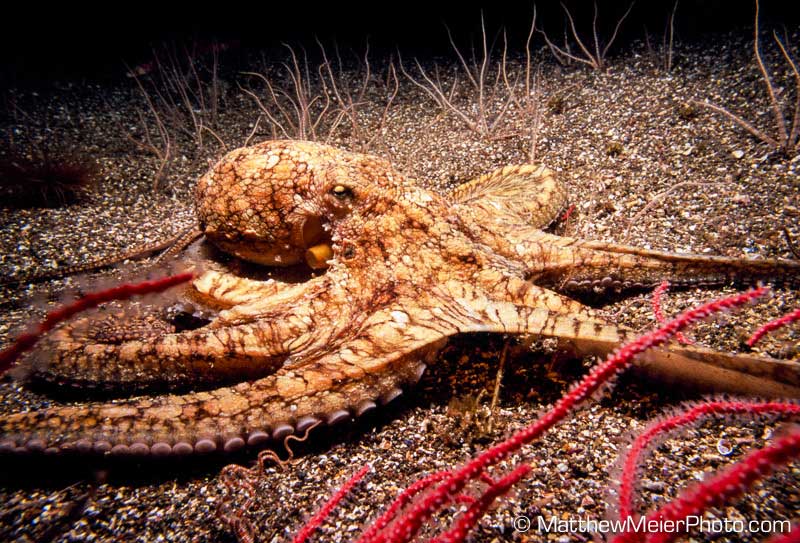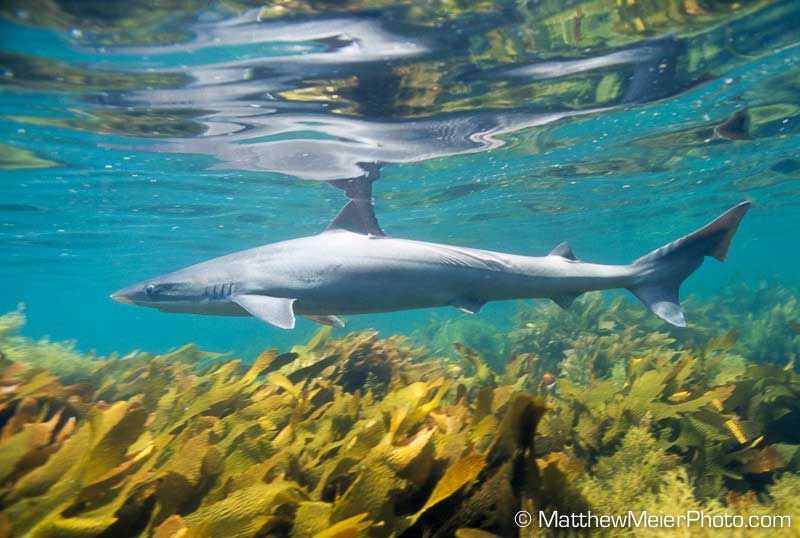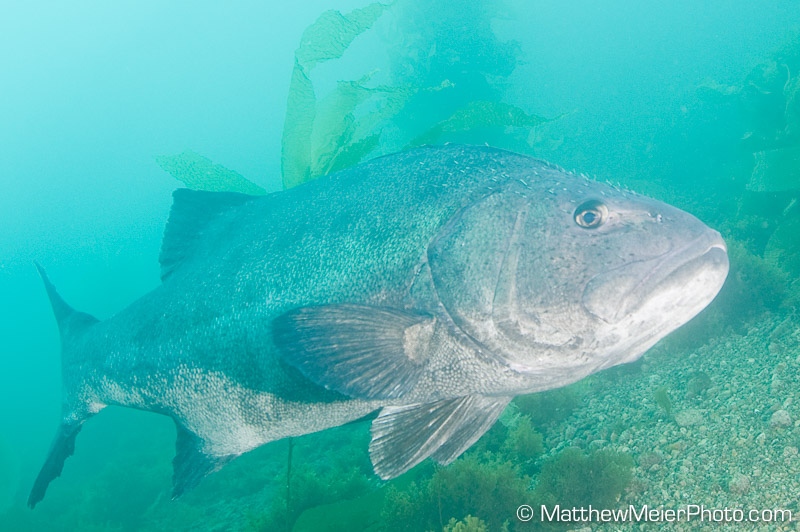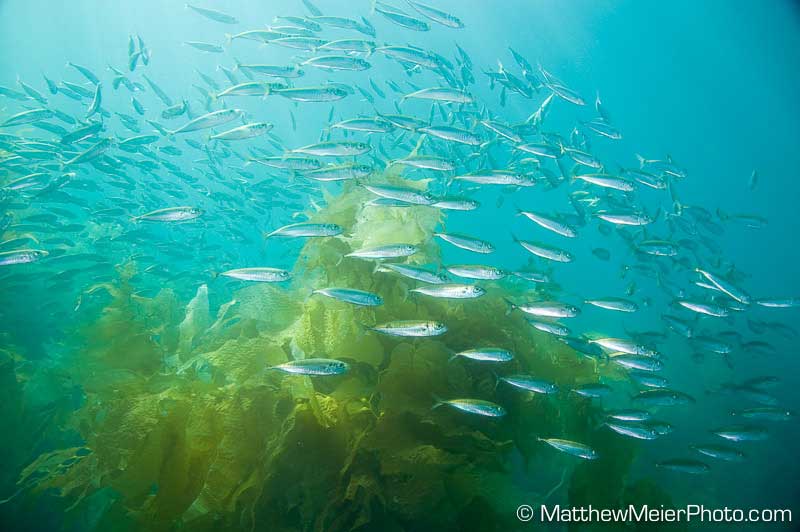For those of us fortunate enough to call Southern California home, the Channel Islands offer world class diving in our own backyard. Comprised of eight islands, stretching over 160 miles of Pacific Ocean, the Channel Islands boast over 2000 terrestrial plants and animals, including 150 endemic species, rivaling the Galapagos for diversity. Below the surface the islands play host to forests of giant kelp and a multitude of abundant marine life, supported by nutrient rich, cold-water upwellings. The rocky reef structure is covered with algae and sponge growth, bryozoans and hydroids, anemones, tubeworms, burrowing sea cucumbers, sea stars, urchins and nudibranchs. Spiny lobster, moray eels and octopus shelter in crevices, while fish species too numerous to mention, range from the resident bright orange Garibaldi to colossal Giant Sea Bass.
Words & Photos by Matthew Meier, www.matthewmeierphoto.com
My first underwater photos were taken at the Channel Islands and I have returned every year since. On a recent trip, the live-aboard spent two days anchored at one dive site, in which time, none of the 20 photographers and videographers onboard, ran out of subjects. We were privileged to have Harbor Seals and California Sea Lions nearby, a vertical wall of rocky reef full of macro subjects, Bat Rays and Angel Sharks in the sand below the boat, and schools of Jack Mackerel, Opaleye and Blacksmith fish, along with Soupfin and Leopard Sharks swimming in the shallow waters of the Giant Kelp forest.
Spectacular to see underwater, Giant Sea Bass are the largest species of fish living in the kelp forest. They can grow to be over seven feet in length and weigh upwards of 700 pounds. Due to their dwindling numbers from over fishing, Giant Sea Bass have been protected in California waters since 1982. While still listed as a Critically Endangered species, Giant Sea Bass are slowly making a come back. Swimming alongside one of these behemoths is truly an amazing experience.
The Channel Islands support numerous shark and ray species. I have had good luck photographing Soupfin and Leopard Sharks at San Clemente Island, Horn Sharks at Catalina and Bat Rays at most all of the islands. It is also possible to see Blue Sharks, Mako Sharks, Angel Sharks, Swell Sharks, Stingrays, Shovelnose Guitarfish and Electric Rays to name a few. In the 1960’s and 70’s, Basking Sharks were common in the Santa Barbara Channel, but by now they have all but disappeared.
No visit to the Channel Islands is complete without an encounter with the charismatic and vibrant Garibaldi, California’s official state salt-water marine fish. They are only found in the Eastern Pacific Ocean from Monterey Bay down to Baja and are abundant at the islands. Garibaldi are the largest member of the damselfish family, growing up to 12 inches in length and are brilliant orange in color. Juvenile Garibaldi’s color is slightly less bold and they have luminous blue spots that disappear by the time they reach adulthood. In summer, male Garibaldi construct circular nests on flat sections of rocky reef and then guard their nests after the female deposits her eggs. They are incredibly territorial during this time period and will attack much larger fish and even humans to protect their developing young.
Scuba diving at the Channel Islands is almost exclusively achieved, by means of a day or multi-day boat trip from the mainland. Dive boats run out of harbors like Santa Barbara, Ventura, Los Angeles, Long Beach, San Pedro, Dana Point and San Diego. Single day trips usually allow for 3-4 dives, before returning back to the docks in late afternoon. Transport times differ depending on the harbor, boat and destination, but most range between 1-2 hours. The charters vary from intimate, six passenger vessels to 30+ passenger live-aboard boats.

Humpback Whale (Megaptera novaeangliae) tail slapping at the water’s surface, also known as a peduncle slap
Diving in California is for the hardy and self-reliant. The water is cold, the gear extensive and the pampering virtually nonexistent. On most boats, divers are required to provide their own equipment, tanks and even weights and to transport that gear onboard themselves. Once in the water, divers are expected to be able to read their compass, manage their bottom time and find their way back to the boat. Dive masters typically do not conduct a follow the leader, guided tour and may not even get wet. The reward for all this effort however, is magnificent diving and absolute freedom underwater. Plus you finally get to prove you were paying attention during that Navigation specialty course.
Santa Catalina Island maintains the only permanent, non-military settlement on the islands, with the majority of residents living in either Avalon or Two Harbors. Boat ferries are the most common means of transportation to Catalina, though helicopter and plane rides are also available. Once on Catalina, there are a wide variety of quaint hotels and restaurants to choose from, the vast majority within walking distance of the ferry dock. Several dive boats operate out of Catalina and shore diving is also available. A must see is the Casino Point Marine Park, which was established as a marine reserve in 1965 by the city of Avalon. This shore dive is easily accessible by concrete steps taking you straight into the water.
A wide variety of marine mammals call the islands home and at various times of the year, many more pass through on their migratory routes. Nearly 30 species of Cetaceans (dolphins and whales) have been observed, with 18 species listed as residents. Pacific Gray Whales migrate during the months of December through March, heading south from their artic feeding grounds towards the warmer waters of Baja California, Mexico, to give birth. In the summer months of July to September, Humpback Whales, Fin Whales and Blue Whales come to feed. This aggregation of Blue Whales is the largest of it’s kind, with nearly 10% of the world’s population gathered in the Santa Barbara Channel. Visitors will frequently see large pods of Common Dolphins and occasionally much smaller pods of Risso’s Dolphins at the surface.
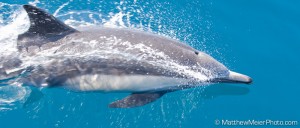
A Common Dolphin (Delphinus delphis) leaps out of the water to get a breath of air while surfing the bow wake
There are four species of Pinnipeds (seals and sea lions) at the islands, including the California Sea Lion, Harbor Seal, Northern Elephant Seal and the Northern Fur Seal. In years past Guadalupe Fur Seals and Stellar Sea Lions also visited the islands, but today are rarely seen. On the northern most island of San Miguel, hundreds of thousands of pinnipeds gather, breeding at different times of the year, to form one of the largest congregations of wildlife in the world.
The leeward side of Santa Barbara Island plays host to a rookery of California Sea Lions. Hundreds of sea lions haul out on the rocks at night to sleep or to laze about in the sun during the day. Pups are born in the spring and learn to swim under the watchful eye of adults in the calm, shallow waters close to shore. By mid-summer they are graceful swimmers and curious to explore their world. This is a popular dive destination and well worth the trip. Some of my most memorable dives have been at Santa Barbara Island watching playful sea lions swim circles around me.
Divers and non-divers alike will relish the beauty and diversity of the Channel Islands. Easily accessible from numerous harbors along the Southern California coast, the islands provide a perfect escape from daily life only a few miles offshore. Whether you are swimming alongside a curious sea lion, watching a pod of dolphin or strolling through a field of wild flowers, the Channel Islands have a little something for everyone.
Matthew Meier is a professional underwater photographer and travel writer based in San Diego, California. To see more of his work and to order prints, please visit: www.matthewmeierphoto.com

